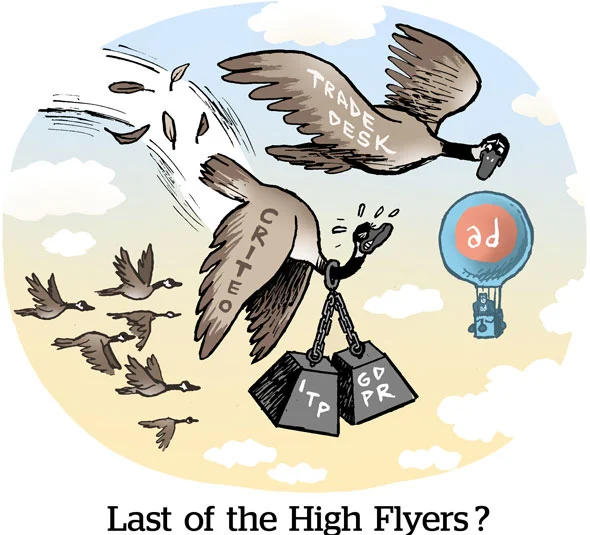A true epoch of ad tech has passed
Criteo’s retargeting revenue was less than half the company’s total earnings in Q3, a first for Criteo, CEO Megan Clarken told investors during the company’s earnings call on Thursday.
Criteo’s net profit ticked up a smidge – from $6.5 million in Q3 2022 to $6.6 million last quarter – and headcount is down 1%.
But the market doesn’t appear to care about Criteo’s retargeting-related milestone. Shares were down more than 10% after the company reported its numbers. That’s because Criteo’s retail media and IPONWEB businesses are passing retargeting as it’s on the way down, having decreased 7% in a year.
The new pitch
Criteo has been reframing its business away from retargeting for the better part of a decade.
In 2017, after The Trade Desk went public, Criteo pushed to be seen as a DSP. It was mar tech after that, followed more recently by a pivot to commerce media.
But Clarken elaborated on some of Criteo’s differentiators in the commerce advertising market.
For one thing, in an overcrowded field of retail media solutions, Criteo is an established name and often considered a key partner for the open web. For instance, Clarken cited Criteo’s integration with Shopify Plus, where it’s the only open internet advertising partner alongside Google, Meta, Pinterest, Snap and TikTok.
Then there’s Criteo’s core ad tech edge. Its identity graph, according to Clarken, has more hashed emails than any other alternative ID provider. These hashed emails (Criteo calls them HEMs, but who needs another acronym?) are the “interoperable match keys” that will pay off most “once the industry moves beyond third-party signals.”
Criteo is also the largest and most committed name aside from Google Ads that’s working with Chrome to test the new Privacy Sandbox advertising and measurement APIs.
The pushback
One reason investors are nonplussed by the subordination of Criteo’s retargeting revenue is that it’s a more profitable type of revenue for the business.
Criteo’s gains in retail media – and, particularly, with the largest retailers – tend to be more SaaS-type tech licensing agreements that are based on mostly fixed rates. And Commerce Max, Criteo’s retail media DSP product, which launched publicly in September, is self-service, so the take rate is smaller there, too.
Criteo is “evolving our pricing models,” Clarken said, to meet the needs (which is to say, the demands) of new, large retailer clients.
Those large retailer clients may help secure Criteo’s footprint in the commerce category, but they aren’t willing to give up a percentage share of growth in a space with so much potential. To avoid sharing a growing portion of their ad businesses, the big chains can insist Criteo take a fixed rate, with preset incentives to reach certain growth numbers.
“These are the things that we’re working through as we’re relatively early in the stage of building up this marketplace,” Clarken said.
Another sticking point is that, while Criteo’s leadership in terms of Chrome Privacy Sandbox product development is one of the company’s three main pillars for short-term growth, that investment is also a risk.“Frankly, we wanted to make sure we were transparent with all of you as we go along this journey,” Criteo CFO Sarah Glickman told investors in reference to why the company wasn’t providing specific guidance for 2024, other than to say it’s lowering growth ambitions for next year.
“The uncertainty includes Privacy Sandbox,” Glickman said, since it’s unclear how the products will fare as third-party cookie deprecation rolls out to general Chrome users beginning next year (not to mention that Google has delayed the deadline twice). We’re now more than a year past the original deadline for third-party cookie removal, and Criteo hasn’t been rewarded for its continued investment in the product toolkit, since third-party cookies are still abundant.
The dynamic is not unlike how an athlete trains every day, even twice a day for years on end, to achieve something that may – or even may not – happen years and years later, Clarken told investors.
That’s something Clarken knows; she was a seemingly surefire Olympics-bound track-and-field athlete from New Zealand before a knee injury sent her on a different career path (i.e., becoming a media exec).
The same goes for the Privacy Sandbox, she said. “And it’s the same story with our positioning as the ad tech provider for commerce media. It is eye on the prize.”
Source: https://www.adexchanger.com/marketers/criteo-is-finally-not-a-retargeting-company-anymore/



